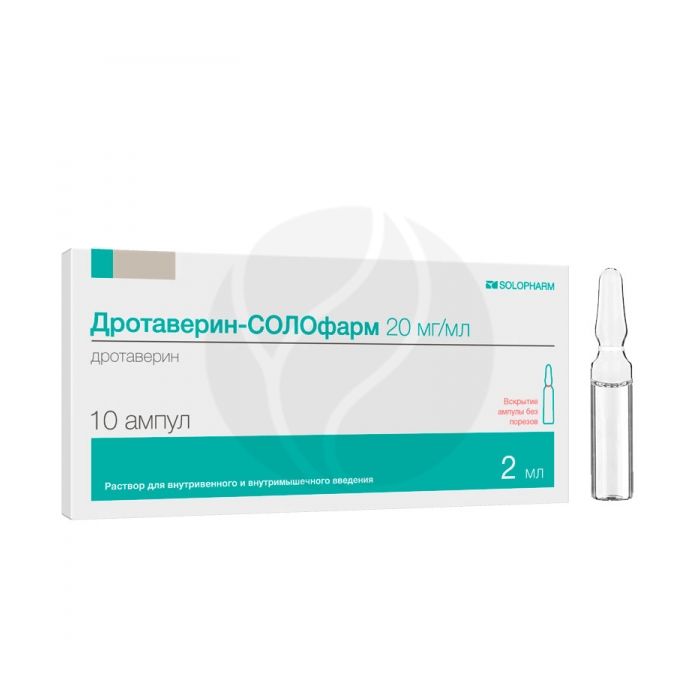Drotaverin-Solofarm solution for injection. 20mg / ml, 2ml # 10
Expiration Date: 11/2025
Russian Pharmacy name:
Дротаверин-солофарм раствор д/инъекц. 20мг/мл, 2мл №10
Spasms of smooth muscles in diseases of the biliary tract (cholecystolithiasis, cholangiolithiasis, cholecystitis, pericholecystitis, cholangitis, papillitis);
spasms of smooth muscles of the urinary tract (nephrolithiasis, urethrolithiasis, pyelitis, cystitis, bladder spasms).
As an auxiliary therapy for spasms of smooth muscles of the gastrointestinal tract (peptic ulcer of the stomach and duodenum, gastritis, spasms of the cardia and pylorus, enteritis, colitis, spastic colitis with constipation, irritable bowel syndrome with flatulence); with tension headaches; with dysmenorrhea; when conducting some instrumental studies, incl. with cholecystography.
For parenteral administration, the average daily dose is 40-240 mg, divided into 1-3 doses per day, intramuscularly. In acute colic (renal or cholelithiasis), a dose of 40-80 mg intravenously is administered slowly (duration of administration is approximately 30 seconds).
Solution for i / v and i / m administration from light yellow or greenish-yellowish to yellow greenish-yellow, transparent or slightly opalescent.
1 ml drotaverine hydrochloride 20 mg
Excipients: ethanol 95% - 67 mg, sodium disulfite - 1 mg, water d / i - up to 1 ml.
For parenteral administration:
AV block II-III degree; period of childbirth.
Carefully:
For parenteral use - with severe atherosclerosis of the coronary arteries, prostate adenoma, glaucoma.
pharmachologic effect
Myotropic antispasmodic. In terms of chemical structure and pharmacological properties, it is close to papaverine, but surpasses it in terms of effectiveness and duration of action.
Drotaverine is effective for smooth muscle spasms of both neurogenic and muscular origin. Regardless of the type of autonomic innervation, drotaverine relaxes the smooth muscles of the gastrointestinal tract, biliary tract, and genitourinary system. Due to its vasodilating action, drotaverine improves tissue blood supply.
Pharmacokinetics
After oral administration, drotaverine is rapidly absorbed from the gastrointestinal tract. After presystemic metabolism, 65% of the dose enters the systemic circulation. Cmax of drotaverine in blood plasma is achieved after 45-60 minutes. Plasma protein binding - 95-98%. It is evenly distributed in tissues, penetrates into smooth muscle cells. Does not penetrate the BBB; drotaverine and / or its metabolites can slightly penetrate the placental barrier. Drotaverine is almost completely metabolized in the liver. T1 / 2 of drotaverine is 8-10 hours. Within 72 hours, drotaverine is almost completely excreted from the body. About 50% is excreted by the kidneys and about 30% through the gastrointestinal tract. Drotaverine is mainly excreted in the form of metabolites; unchanged form of drotaverine is not detected in urine.
When administered parenterally, drotaverine is rapidly absorbed. Bioavailability is 100%. The onset of action is after 2-4 minutes. Cmax in blood plasma is reached after 30-40 minutes.
Side effect
From the nervous system: rarely - headache, dizziness, insomnia.
From the side of the cardiovascular system: rarely - a feeling of palpitations, lowering blood pressure; with parenteral administration - arrhythmia, tachycardia, collapse (with intravenous administration).
From the digestive system: rarely - nausea, constipation.
Allergic reactions: rarely - angioedema, urticaria, rash, itching; with parenteral administration in some cases - anaphylactic shock.
Local reactions: with parenteral administration, rarely - reactions at the injection site.
Application during pregnancy and lactation
Use during pregnancy is possible only in cases where the potential benefit to the mother outweighs the potential risk to the fetus.
Contraindicated for use during lactation (breastfeeding). If necessary, use during lactation should decide on the termination of breastfeeding.
Application for violations of liver function
Use is contraindicated in case of severe liver dysfunction.
Application for impaired renal function
It is contraindicated for use in severe renal impairment.
Application in children
Taking drotaverine inside is contraindicated in children under 6 years of age.
Parenteral use of drotaverine is contraindicated in children and adolescents under the age of 18 years.
Use in elderly patients
Caution should be given to elderly patients in order to avoid worsening of the course of concomitant diseases.
special instructions
With the on / in the introduction of drotaverine, the patient should be in a horizontal position due to the risk of collapse.
Use in pediatrics
Use drotaverine (for oral administration) with caution in children. Parenteral use in children is contraindicated.
Influence on the ability to drive vehicles and use mechanisms
During the period of using drotaverine, it is necessary to refrain from driving vehicles and engaging in other potentially hazardous activities that require increased concentration of attention and speed of psychomotor reactions (within 1 hour after parenteral administration, especially IV).
Drug interactions
With simultaneous use with tricyclic antidepressants, quinidine, procainamide, the decrease in blood pressure caused by tricyclic antidepressants, quinidine and procainamide increases.
With simultaneous use, the spasmogenic activity of morphine decreases.
With simultaneous use with levodopa, it is possible to reduce the antiparkinsonian effect of levodopa.
With simultaneous use, the effect of papaverine, bendazole and other antispasmodics (including m-anticholinergics) is enhanced.
With simultaneous use with phenobarbital, the severity of the antispasmodic effect of drotaverine increases.

